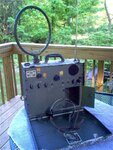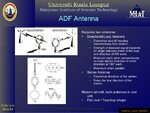elektrotechnik
Junior Member level 1
Hi all,
I am looking to improve my circuit design, PCB prototyping and fabbing skills and I am looking for a project to take up some of my time this winter. I am looking to build my own avalanche transceiver from the ground up, and I was hoping that I could come here for some direction.
I am looking to replicate something similar to the Backcountry Access avalanche transceiver shown here: **broken link removed**. I am not looking to build something with this level of direction sensing and output, but rather something more barebones.
I only found one post on the forums that specifically talked about the design of a 457kHz transmitter, and that is found here: **broken link removed**.
From what I gleaned:
For the receiver:
I would suggest a JFET, source follower then a second filter, possibly a ceramic IF filter then a high gain stage. Also consider rectifying the received signal before measuring it. At the moment it appears you are trying to digitize the RF which plays no useful purpose and makes it far more complicated. The transmitted signal is pulsed, if you average the pulse levels and use that as your measurement it will be less susceptible to interference and give a more stable reading.
For the transmitter:
In the transmitter, you really want a clean sine wave at the output and as much RF delivered to the antenna as possible within the limitations of the battery life. If you use the digital divider method, apply filtering to the signal to remove harmonics before amplifying it and use a simple keyed supply amplifier using a single transistor. Match it's output to the antenna with a pi network or tapped coil to maximize energy transfer and also minimize the chance of causing interference. Incidentally, to cover 50m (metres) range reliably you should only need about 5mW output power.
I also found this block diagram from Colorado EE (ecee.colorado.edu/~ecen4610/expos13/accubeacon_CDR.pptx
):

This is the transmitter circuit from the powerpoint. Is this a good place to start? How do I choose the Crystal Oscillator? What is confined to the Micro?

I don't have a huge background in hardware design, so I am pretty lost in this thread.
If I am looking to build a basic barebones 457kHz transceiver, what should be my first steps?
Thanks for your help!
I am looking to improve my circuit design, PCB prototyping and fabbing skills and I am looking for a project to take up some of my time this winter. I am looking to build my own avalanche transceiver from the ground up, and I was hoping that I could come here for some direction.
I am looking to replicate something similar to the Backcountry Access avalanche transceiver shown here: **broken link removed**. I am not looking to build something with this level of direction sensing and output, but rather something more barebones.
I only found one post on the forums that specifically talked about the design of a 457kHz transmitter, and that is found here: **broken link removed**.
From what I gleaned:
For the receiver:
I would suggest a JFET, source follower then a second filter, possibly a ceramic IF filter then a high gain stage. Also consider rectifying the received signal before measuring it. At the moment it appears you are trying to digitize the RF which plays no useful purpose and makes it far more complicated. The transmitted signal is pulsed, if you average the pulse levels and use that as your measurement it will be less susceptible to interference and give a more stable reading.
For the transmitter:
In the transmitter, you really want a clean sine wave at the output and as much RF delivered to the antenna as possible within the limitations of the battery life. If you use the digital divider method, apply filtering to the signal to remove harmonics before amplifying it and use a simple keyed supply amplifier using a single transistor. Match it's output to the antenna with a pi network or tapped coil to maximize energy transfer and also minimize the chance of causing interference. Incidentally, to cover 50m (metres) range reliably you should only need about 5mW output power.
I also found this block diagram from Colorado EE (ecee.colorado.edu/~ecen4610/expos13/accubeacon_CDR.pptx
):

This is the transmitter circuit from the powerpoint. Is this a good place to start? How do I choose the Crystal Oscillator? What is confined to the Micro?
I don't have a huge background in hardware design, so I am pretty lost in this thread.
If I am looking to build a basic barebones 457kHz transceiver, what should be my first steps?
Thanks for your help!
Last edited:

